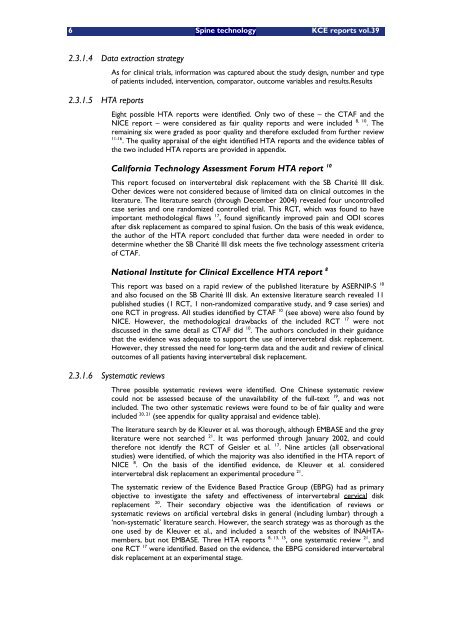Report in English with a French summary - KCE
Report in English with a French summary - KCE
Report in English with a French summary - KCE
You also want an ePaper? Increase the reach of your titles
YUMPU automatically turns print PDFs into web optimized ePapers that Google loves.
6 Sp<strong>in</strong>e technology <strong>KCE</strong> reports vol.39<br />
2.3.1.4 Data extraction strategy<br />
2.3.1.5 HTA reports<br />
As for cl<strong>in</strong>ical trials, <strong>in</strong>formation was captured about the study design, number and type<br />
of patients <strong>in</strong>cluded, <strong>in</strong>tervention, comparator, outcome variables and results.Results<br />
Eight possible HTA reports were identified. Only two of these the CTAF and the<br />
NICE report were considered as fair quality reports and were <strong>in</strong>cluded 8, 10 . The<br />
rema<strong>in</strong><strong>in</strong>g six were graded as poor quality and therefore excluded from further review<br />
11-16 . The quality appraisal of the eight identified HTA reports and the evidence tables of<br />
the two <strong>in</strong>cluded HTA reports are provided <strong>in</strong> appendix.<br />
California Technology Assessment Forum HTA report 10<br />
This report focused on <strong>in</strong>tervertebral disk replacement <strong>with</strong> the SB Charité III disk.<br />
Other devices were not considered because of limited data on cl<strong>in</strong>ical outcomes <strong>in</strong> the<br />
literature. The literature search (through December 2004) revealed four uncontrolled<br />
case series and one randomized controlled trial. This RCT, which was found to have<br />
important methodological flaws 17 , found significantly improved pa<strong>in</strong> and ODI scores<br />
after disk replacement as compared to sp<strong>in</strong>al fusion. On the basis of this weak evidence,<br />
the author of the HTA report concluded that further data were needed <strong>in</strong> order to<br />
determ<strong>in</strong>e whether the SB Charité III disk meets the five technology assessment criteria<br />
of CTAF.<br />
National Institute for Cl<strong>in</strong>ical Excellence HTA report 8<br />
This report was based on a rapid review of the published literature by ASERNIP-S 18<br />
and also focused on the SB Charité III disk. An extensive literature search revealed 11<br />
published studies (1 RCT, 1 non-randomized comparative study, and 9 case series) and<br />
one RCT <strong>in</strong> progress. All studies identified by CTAF 10 (see above) were also found by<br />
NICE. However, the methodological drawbacks of the <strong>in</strong>cluded RCT 17 were not<br />
discussed <strong>in</strong> the same detail as CTAF did 10 . The authors concluded <strong>in</strong> their guidance<br />
that the evidence was adequate to support the use of <strong>in</strong>tervertebral disk replacement.<br />
However, they stressed the need for long-term data and the audit and review of cl<strong>in</strong>ical<br />
outcomes of all patients hav<strong>in</strong>g <strong>in</strong>tervertebral disk replacement.<br />
2.3.1.6 Systematic reviews<br />
Three possible systematic reviews were identified. One Ch<strong>in</strong>ese systematic review<br />
could not be assessed because of the unavailability of the full-text 19 , and was not<br />
<strong>in</strong>cluded. The two other systematic reviews were found to be of fair quality and were<br />
<strong>in</strong>cluded 20, 21 (see appendix for quality appraisal and evidence table).<br />
The literature search by de Kleuver et al. was thorough, although EMBASE and the grey<br />
literature were not searched 21 . It was performed through January 2002, and could<br />
therefore not identify the RCT of Geisler et al. 17 . N<strong>in</strong>e articles (all observational<br />
studies) were identified, of which the majority was also identified <strong>in</strong> the HTA report of<br />
NICE 8 . On the basis of the identified evidence, de Kleuver et al. considered<br />
<strong>in</strong>tervertebral disk replacement an experimental procedure 21 .<br />
The systematic review of the Evidence Based Practice Group (EBPG) had as primary<br />
objective to <strong>in</strong>vestigate the safety and effectiveness of <strong>in</strong>tervertebral cervical disk<br />
replacement 20 . Their secondary objective was the identification of reviews or<br />
systematic reviews on artificial vertebral disks <strong>in</strong> general (<strong>in</strong>clud<strong>in</strong>g lumbar) through a<br />
non-systematic literature search. However, the search strategy was as thorough as the<br />
one used by de Kleuver et al., and <strong>in</strong>cluded a search of the websites of INAHTAmembers,<br />
but not EMBASE. Three HTA reports 8, 13, 15 , one systematic review 21 , and<br />
one RCT 17 were identified. Based on the evidence, the EBPG considered <strong>in</strong>tervertebral<br />
disk replacement at an experimental stage.

















